Related Research Articles
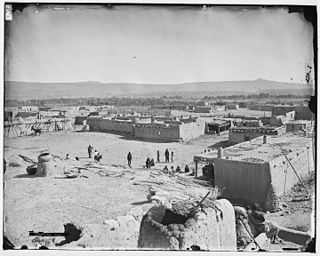
Cochiti is a census-designated place (CDP) in Sandoval County, New Mexico, United States. A historic pueblo of the Cochiti people, one of the Keresan Nations, it is part of the Albuquerque Metropolitan Statistical Area. The population was 528 at the 2010 census. Located 22 miles (35 km) southwest of Santa Fe, the community is listed as a historic district on the National Register of Historic Places.

Kewa Pueblo is a federally-recognized tribe of Native American Pueblo people in northern New Mexico, in Sandoval County southwest of Santa Fe. The pueblo is recorded as the Santo Domingo Pueblo census-designated place by the U.S. Census Bureau, with a population of 2,456 at the 2010 census.

Native American pottery is an art form with at least a 7500-year history in the Americas. Pottery is fired ceramics with clay as a component. Ceramics are used for utilitarian cooking vessels, serving and storage vessels, pipes, funerary urns, censers, musical instruments, ceremonial items, masks, toys, sculptures, and a myriad of other art forms.

Maria Poveka Montoya Martinez was a Native American artist who created internationally known pottery. Martinez, her husband Julian, and other family members, including her son Popovi Da, examined traditional Pueblo pottery styles and techniques to create pieces which reflect the Pueblo people's legacy of fine artwork and crafts. The works of Maria Martinez, and especially her black ware pottery, survive in many museums, including the Smithsonian, the Metropolitan Museum of Art, the Denver Art Museum, and more. The Penn Museum in Philadelphia holds eight vessels – three plates and five jars – signed either "Marie" or "Marie & Julian".

Crucita Gonzalez Calabaza, also known as Blue Corn, was a Native American artist and potter from San Ildefonso Pueblo, New Mexico, in the United States. She became famous for reviving San Ildefonso polychrome wares and had a very long and productive career.
Marie Zieu Chino (1907–1982) was a Native American potter from Acoma Pueblo, New Mexico. Marie and her friends Lucy M. Lewis and Jessie Garcia are recognized as the three most important Acoma potters during the 1950s. Along with Juana Leno, they have been called "The Four Matriarchs" who "revived the ancient style of Acoma pottery." The inspiration for many designs used on their pottery were found on old potsherds gathered to use for temper. Together they led the revival of ancient pottery forms including the Mimbres, Tularosa and other various cultures in the Anasazi region. This revival spread to other potters who also accepted the old styles, which led to new innovative designs and variations of style and form.
Arthur and Hilda Coriz were Native American husband and wife potters from Santo Domingo Pueblo, New Mexico, United States. They signed their pottery as "Arthur and Hilda Coriz."
Margaret Gutierrez and Luther Gutierrez (1911–1987) were a brother and sister team of Native American potters from Santa Clara Pueblo, New Mexico, United States. They descended from several generations of potters and continue the polychrome style of painting made famous by their parents Lela and Van Gutierrez. At age twelve, Margaret began apprenticing as a potter with her mother. Luther's father taught him where to find, and how to process the clay. Margaret and Luther began making pottery together in the 1960s.
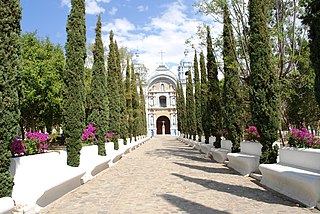
Ocotlán de Morelos is a town and municipality in the state of Oaxaca, about 35 km south of the center of the city of Oaxaca along Highway 175. It is part of the Ocotlán District in the south of the Valles Centrales Region. The area was a significant population center at the time of the Spanish Conquest, and for that reason an important Dominican monastery was established here in the 16th century. The complex still exists, with the church still being used for worship and the cloister area used as a museum. While mostly quiet, the city is an important distribution and transportation center for the south of the Central Valleys region of Oaxaca, a function which is expected to be reinforced with the opening of new highway being built to connect the city of Oaxaca with the Pacific coast. The city is known for artist Rodolfo Morales, who painted aspects of his hometown in his works and sponsored projects to save and restore historic monuments here. For generations the municipality has been known for its crafts, with the ceramics making Aguilar family producing some of the best known craftsmen.

Art of the American Southwest is the visual arts of the Southwestern United States. This region encompasses Arizona, New Mexico, and parts of California, Colorado, Nevada, Texas, and Utah. These arts include architecture, ceramics, drawing, filmmaking, painting, photography, sculpture, printmaking, and other media, ranging from the ancient past to the contemporary arts of the present day.

Dextra Quotskuyva Nampeyo is a Native American potter and artist. She is in the fifth generation of a distinguished ancestral line of Hopi potters.
Lisa Holt and Harlan Reano are a husband-and-wife team of Pueblo potters and artists from northern New Mexico. They have been making pottery together in 1999, they use traditional Cochiti pottery techniques and create modern work.
Elizabeth Toya Medina is a Pueblo potter. She married into the Zia tribe in 1978 and, as is traditional, gained tribal permission to use Zia designs in her work. Her first pots were in the Jemez style. In some instances she has collaborated with her mother-in-law, Sofia Medina, whom she cites as her inspiration.

Mary Ellen Toya (1934–1990) was a Jemez Pueblo potter of the Water Clan. She was active ca. 1950–1990, and was known for creating some of the largest Storyteller figures.
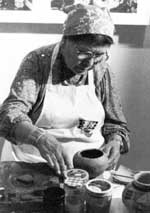
Daisy Hooee Nampeyo was a Hopi-Tewa potter. She studied at École des Beaux-Arts. Hooee taught pottery making on the Zuni reservation and helped preserve the traditional techniques she learned from her grandmother, Nampeyo.

Black-on-black ware is a 20th- and 21st-century pottery tradition developed by Puebloan Native American ceramic artists in Northern New Mexico. Traditional reduction-fired blackware has been made for centuries by Pueblo artists and other artists around the world. Pueblo black-on-black ware of the past century is produced with a smooth surface, with the designs applied through selective burnishing or the application of refractory slip. Another style involves carving or incising designs and selectively polishing the raised areas. For generations several families from Kha'po Owingeh and P'ohwhóge Owingeh pueblos have been making black-on-black ware with the techniques passed down from matriarch potters. Artists from other pueblos have also produced black-on-black ware. Several contemporary artists have created works honoring the pottery of their ancestors.
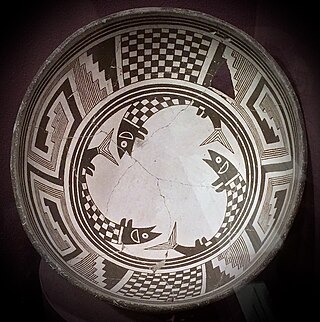
Pueblo pottery are ceramic objects made by the indigenous Pueblo people and their antecedents, the Ancestral Puebloans and Mogollon cultures in the Southwestern United States and Northern Mexico. For centuries, pottery has been central to pueblo life as a feature of ceremonial and utilitarian usage. The clay is locally sourced, most frequently handmade, and fired traditionally in an earthen pit. These items take the form of storage jars, canteens, serving bowls, seed jars, and ladles. Some utility wares were undecorated except from simple corrugations or marks made with a stick or fingernail, however many examples for centuries were painted with abstract or representational motifs. Some pueblos made effigy vessels, fetishes or figurines such as Cochiti Pueblo. During modern times, pueblo pottery was produced specifically as an art form to serve an economic function. This role is not dissimilar to prehistoric times when pottery was traded throughout the Southwest, and in historic times after contact with the Spanish colonialists.
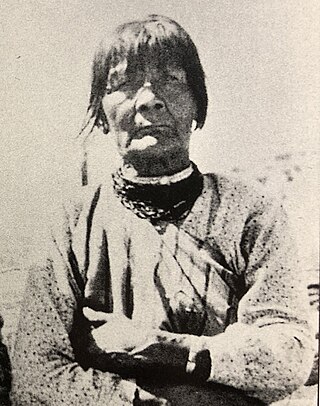
Sara Fina Gutiérrez Tafoya (1863-1949) was a Tewa matriarch potter from Kha'po Owingeh, New Mexico.
Robert Tenorio is a Kewa potter.
References
- 1 2 3 "Native People in the Southwest Label Copy". Heard Guild. Retrieved 2019-02-01.
- ↑ "Santo Domingo Pottery: Santo Domingo Jar by the Aguilar Sisters, 1910". Steve Elmore Indian Art. Retrieved 2019-02-01.
- 1 2 "Online Collection: Jar". Denver Art Museum. Retrieved 2019-02-01.
- ↑ "Olla (Water Jar) Asuncion Aguilar Caté, Felipita Aguilar García". Brooklyn Museum. Retrieved 2019-02-01.
- ↑ "Artists: Felipita Aguilar Garcia". Nelson Atkins Museum of Art.